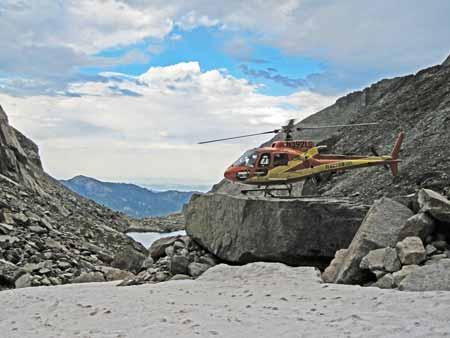Despite occasional news stories about people who refuse to get involved when they see someone in distress, a recent incident at Rocky Mountain National Park confirms that most park visitors are willing to pitch in when things go wrong. Several climbers provided invaluable help when a fellow mountaineer came to grief high on Longs Peak.
The climb of Long's Peak at Rocky Mountain is a popular one, but an ascent of the 14,259-foot mountain—the highest in the park—is also a challenging one. A park brochure notes, "The hike is long and strenuous, with a continuous elevation gain of 4,850 feet over 7.5 miles…Proper physical conditioning is paramount." In addition to those headed for the summit itself, the area is also a destination for technical climbers.
Most climbers are on the trail well before dawn, and that's early indeed during the summer in the Rockies, so by afternoon anyone still on the mountain has had plenty of exercise. Those long hours and likely weary muscles didn't stop eight visitors from coming to the aid of a climber who wasn't part of their group last Saturday, and their help made a big difference in a timely rescue.
At about 2:23 p.m. on Saturday, July 17, rangers received a report that a climber had seriously injured both ankles on Stettner's Ledges near Mills Glacier on Longs Peak. William Esposito, 27, from Boulder, Colorado, was on a technical climb and took a 20-foot fall while leading on the ascent.
That's a location where help is not often close at hand, but several factors were in Mr. Esposito's favor.
A pair of park rangers was on a backcountry patrol near the summit of Longs Peak, and thanks to their location and modern communications, they were able to learn about the problem and reach the victim at 4:53 p.m. That's a quick response in this remote setting.
The rangers discovered that despite Esposito's injuries, he and his climbing partner had made remarkable efforts to aid in his rescue. The victim's partner had safely lowered him an additional three pitches, making it easier for rangers to assist him. Although Esposito could not put weight on his feet, he and his climbing partner had also tried to move as far down the snowfield as possible.
The two rangers picked up search and rescue gear at the nearby Chasm Shelter, and with the help of eight other climbers who were in the area, carried gear and the litter with Esposito to a helicopter landing zone near Chasm Lake (elevation 11,760 ft.).
Moving an injured adult in a litter any distance by hand is a workout even on level pavement; in rough terrain at high elevation it's a grueling job, and this speedy transfer would not have been possible without the help of the other climbers.
This was a situation where time was an important factor; an air evacuation needed to be completed while there was adequate daylight. Thanks to the prompt litter evacuation, a Flight for Life helicopter from St. Anthony's Hospital was able to land in the area, and flew Esposito to Boulder Community Hospital at 6:37 p.m.
Park spokesperson Kyle Patterson commented that "Park rangers were grateful for the assistance of the climbers in the area. Although all of the climbers happened to be from Boulder, they were all in different groups. The rescue efforts made for a long day for the climbers as they had all left the Longs Peak Trailhead before dawn. Their assistance to park rangers in carrying Esposito to the landing zone enabled the helicopter to be able to fly during daylight."
Other visitors who were miles from the rescue and unaware of the emergency also benefited from the help rendered by the Good Samaritans. Patterson noted, "Because of their assistance, additional park staff did not have to hike to the area, allowing them to focus on other operations on a busy Saturday in July at Rocky Mountain National Park."


 Support Essential Coverage of Essential Places
Support Essential Coverage of Essential Places






